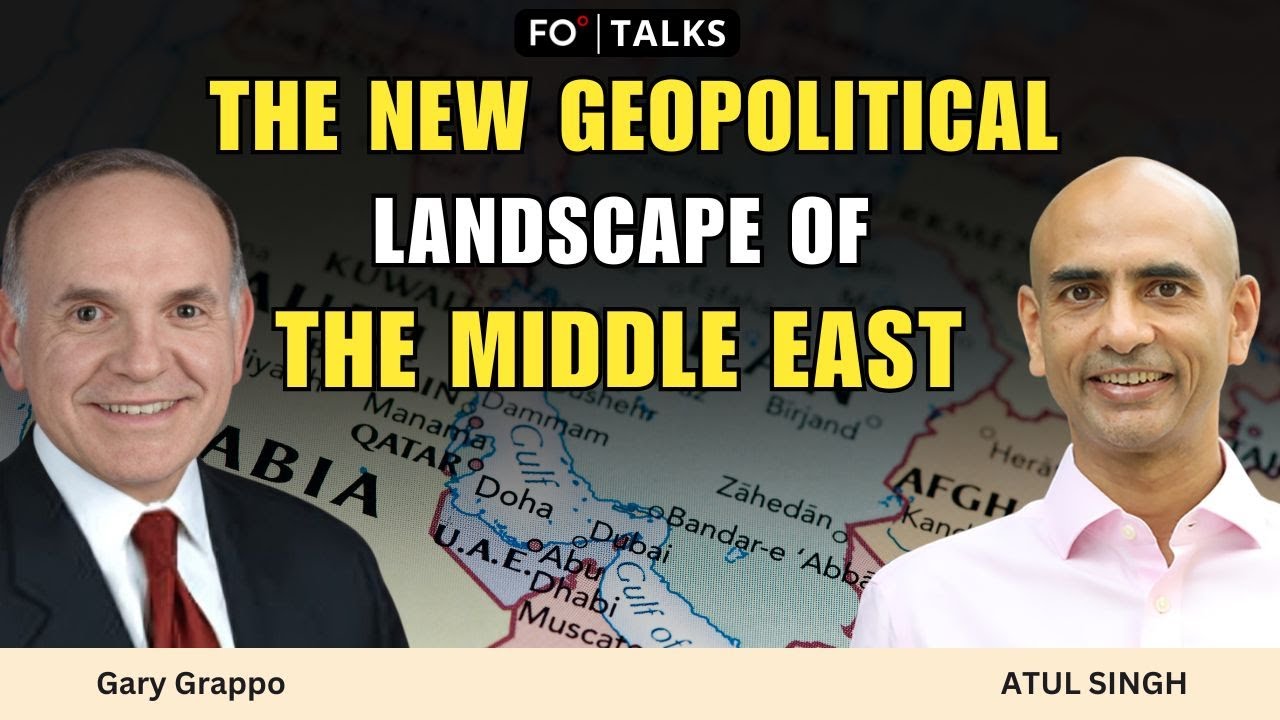[This is the eighth part of a nine-part series. To read more, see Parts 1, 2, 3, 4, 5, 6 and 7 here.]
Josef Olmert: Hello, I’m doing today the penultimate one, which will be a summation of the main points which I made until now. And then the next one will be like some, if you will, assessments/predictions about the foreseeable future of Syria as a result of all that we have discussed until now and the recent developments there. When we talk about recent developments, I would just mention that there still are clear signs that despite the impression created in the Western world, mainly because of the Western media — which, as usual, particularly, the American media — doesn’t really cover what really is happening on the ground. The impression is that Ahmed Sharaa, or Abu Muhammad al-Julani, the leader of the main group that took over now in Damascus, Hay’at Tahrir al-Sham, that he is in full control of Syria and is the new ruler. And it is not the case. I repeat, this is not the case. I’ll give you an example. His people sent a convoy, a kind of military-civilian convoy, to the Druze areas of South Lebanon in order to assert their authority there. And they were basically sent back after the Druze threatened to resist violently because, from the Druze perspective, any future of South Lebanon — something that we already discussed in this series, and I will come back to this later on today — has to be negotiated between them and the government in Damascus. Which is to indicate to you that the Druze will insist from now on — and I will explain more about that — some kind of autonomous self-rule regime in South Syria, more or less like the SDF or the Kurdish people are demanding and still experiencing and exercising in the northeast of Syria.
Historical context and persistent instability
So that’s just an indication of how fragile, still precarious, all these so-called central regime in Damascus. And another point about that is that when we look at the media in the West and the way they cover the situation in the Middle East, there’s always this tendency to apply impressions that we have about our own systems in the West to the other side of the world — in that case, the Middle East. And because we see al-Sharaa now in a suit and tie sitting in his nice chair in one of the buildings that they took over in Damascus — so there is a new government, there is a new regime and there is stability. No, there isn’t, and it doesn’t work like that. And it doesn’t work like that because of what we have seen in this series. So let’s sum up, therefore, the main points of what has really happened in Syria, which was leading to the current situation, to the downfall of the Assad regime. I will start with the most fundamental basic point, and this is that Syria, as of 1920, for over a century, has not been able — I will repeat, has not been able — to establish a legitimate, stable political entity which is supported by the vast majority of its people. Whether they like every aspect of government in Damascus or not, but because they share some common values — a fundamental kind of values basis for agreement between various groups, various ethnic groups, various religious groups. And because they share all these values, they accept whatever is the regime in Damascus as a legitimate and stable one. It has never happened in Syria. And the greatest failure, of course, of independent Syria since 1946 — until 1946, you could always argue it’s the fault of the mandatory system, the French. And yes, the French did apply divide and rule in Syria, promoting the Alawis, for example, to an extended role; the Christians, not really touching upon the Kurds in the northeast — all in order to weaken the Sunni Arab majority. And then they created Lebanon, separated from Syria, carving it up from Syria. Yes, but the French basically were playing up, not creating, divisions that existed before for centuries. This was the history of all this region. So the failure of the Syrian state at the end of 1946 was exactly that: the inability to overcome all these problems and to create a stable state. Syria is therefore the modern country of the failing Middle East state.
The Ba’ath regime’s contradictions
In the case of Syria, it was even more dramatic than in other cases, for example, because for three and a half years, between February of 1958 — as we mentioned — and September of 1961, they even agreed to cancel their own separate independence and to unite with Egypt, the much bigger and stronger Egypt of Nasser, into the United Arab Republic, as it was called, which was basically Egypt plus greater Egypt, because they did not find a way to maintain Syria as an independent state. So much so, the failure was so big. The Ba’ath regime gave you the aura, the soul, the sense of stability. Because you can argue they existed from 1963 until 2024 — that is to say, over 60 years. But even that was not the case for various reasons, because the ironic situation is — and this is something that has to be dealt with more extensively in a separate maybe series, but definitely not in this one, but I will mention it and just say something about it — the basic historic irony of the Ba’ath Party is that the party claiming to be the biggest, greatest, most comprehensive embodiment of Arab nationalism, of Pan-Arabism, became — and we talk about Ba’ath in Syria, not about the Ba’ath in Iraq — in the case of Syria, they became the party of the minorities, which through its so-called secular character of the party tried to create a political community which will surpass the ethnic and religious differences and give the minorities the sense of sharing in the running of the state, of equality. But this was resented by the Sunni majority from day one.
Assadism and the end of Syrian statehood
The Sunni opposition to the Ba’ath regime was already in place in 1964–65, and in the same places where it would be later on, on occasions — central Syria, Hama, Homs and other parts of Syria — with the Sunni alliances, so to speak. And the Ba’ath regime already in 1964–65 was bombarding mosques, attacking the Sunni population, even more so after the rise of the so-called Neo-Ba’aths in the coup d’état of the 23rd of February, 1966. And definitely after Assad came to power finally as the one and only dictator as of November of 1970, in what they called Harakat al-Tashih, the Movement of Corrections — that is to say, correcting the early Ba’ath regime. The Ba’ath regime of Assad was basically a three-pillar kind of regime. It was Ba’athism as the framework of political legitimacy. It was Alawism as the main force which really upheld the regime and kept it going. And it was Assadism, because of the personality cult of Hafez Assad and his family. And his family, by the way, is just one part of one of the four big confederate tribal connections of the Alawi community — which is, again, something that should be much more detailed and developed in a series like this. But we couldn’t do all this in this particular series. I still keep the option open for more on Syria in the foreseeable future, and there will be — in which I will dwell more specifically into any of the main communities in Syria, their history, their religion and so on and so forth. So the failure of the Ba’ath regime of Hafez Assad to create this real unity — other than using brutal force — and then of his son, Bashar, is the failure of the Syrian political entity as such. Syria failed to become a legitimate, united, stable political entity. It failed. And now with the rise of the Muslim, Islamist rulers — the Islamic, the Sunnis, whatever we would call them, Jihadists — pick out your name. This might be another attempt to create a community. Pan-Arabism failed, Ba’athism afterwards failed — by pan-Arabism, I mean the unity with Egypt and Ba’athism in Syria. And before, the various attempts at parliamentary democracy, with all the coup d’états and so on and so forth. So what we see really is not just the collapse of the regime. It is another dramatic indication of the collapse of the idea of statehood in a country like Syria. And the name of the new rulers, Hay’at Tahrir al-Sham — Bilad al-Sham is more than Syria and its current borders. It is another, not-so-implicit indication of the problematic of the Syrian existence. What? Where? How? What’s Syria? What borders? Is it Bilad al-Sham, which is Syria, Lebanon, Israel, Palestinian territories, Jordan? Wow. Is it only Syria? And the problem about identity throughout Syrian history has not been just one that was exemplified by the changes in the Ba’aths’ own ideology — from pan-Arabism, unity with Egypt, to particular Syrianism. Look also at the Syrian National Syrian Party of Antoun Saadeh, the famous SSNP, the party that talked about Greater Syria, the party that was supposed to be the enemy of Ba’aths ideologically, because they were pan-Syrians as opposed to pan-Arabists. And later on, they started to cooperate with each other. But they also — the Palestinians — talked about Syria beyond its borders today. That is to say, the problem of Syrian stability and legitimacy, as was exemplified by the downfall of another attempt at creating one state which seemed to be working because it lasted for so many years, the failure of all that is maybe indicating something much more fundamental: the artificiality of the entire political system that was created in the Middle East after the First World War. The creation of states that did not really reflect stable, long-standing historic geopolitical contexts, entities, legacies. Syria is the example of that, and that’s what happened in Syria. So before we talk about the chances of the new regime in Syria — the ability of the new regime to survive — all this has to be seen in historic perspective. And the perspective is that, until now, any attempt in creating stability in Syria failed. So it is too early, far too early, to already give praise to a new regime like, “This is the new Syria.” Maybe the new Syria in terms of who is sitting in the palaces of power in Damascus. But it will not be a new Syria in terms of the final creation of a stable, legitimate, everlasting political entity. So that remains to be seen. And this is basically the main something, the main item, the main topic that I wanted to emphasize in this series. Next time, we shall talk about some future predictions in terms of the specifics of Syria’s relations with other countries and also the domestic situation in Syria. That remains to be seen. Again, it will be a very careful attempt to make some predictions. It is still a fluid, not-so-stable situation. Thank you very much for your attention.
[Lee Thompson-Kolar edited this piece.]
The views expressed in this article/video are the author’s own and do not necessarily reflect Fair Observer’s editorial policy.







































Comment